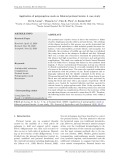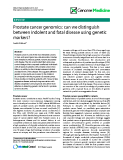
Prostatic disease
-
Loss of prostate cancer differentiation or de-differentiation leads to an untreatable disease. Patient survival would benefit if this can be prevented or reversed. Cancer de-differentiation transforms luminal-like (differentiated) adenocarcinoma into less luminal-like and more stem-like (undifferentiated) small cell carcinoma through a sequential activation of stem cell transcription factors (scTF) POU5F1, LIN28A, SOX2 and NANOG.
 13p
13p  vielonmusk
vielonmusk
 21-01-2022
21-01-2022
 11
11
 0
0
 Download
Download
-
This study was conducted at Sasaki Animal Hospital in Ho Chi Minh City to manage this disease by the synthetic mesh implant. A 10-year castrated male Pomeranian (5.2 kg) was referred to clinical examination because of a 4-month complaint of the return of a mass at the perineal area.
 9p
9p  larachdumlanat129
larachdumlanat129
 19-01-2021
19-01-2021
 12
12
 2
2
 Download
Download
-
Tuyển tập báo cáo các nghiên cứu khoa học quốc tế ngành y học dành cho các bạn tham khảo đề tài: Prostate cancer genomics: can we distinguish between indolent and fatal disease using genetic markers?
 7p
7p  panasonic02
panasonic02
 15-12-2011
15-12-2011
 35
35
 4
4
 Download
Download
-
Tuyển tập các báo cáo nghiên cứu về y học được đăng trên tạp chí y học Critical Care giúp cho các bạn có thêm kiến thức về ngành y học đề tài: Transcriptional profiling of inductive mesenchyme to identify molecules involved in prostate development and disease...
 14p
14p  coxanh_8
coxanh_8
 05-11-2011
05-11-2011
 50
50
 5
5
 Download
Download
-
Benign Disease Symptoms Benign proliferative disease may produce hesitancy, intermittent voiding, a diminished stream, incomplete emptying, and postvoid leakage. The severity of these symptoms can be quantitated with the self-administered American Urological Association Symptom Index (Table 91-2), although the degree of symptoms does not always relate to gland size. Resistance to urine flow reduces bladder compliance, leading to nocturia, urgency, and, ultimately, urinary retention.
 9p
9p  konheokonmummim
konheokonmummim
 03-12-2010
03-12-2010
 79
79
 4
4
 Download
Download
-
Metastatic Disease: Castrate Castration-resistant disease can manifest in many ways. For some it is a rise in PSA with no change in radiographs and no new symptoms. In others it is a rising PSA and progression in bone with or without symptoms of disease. Still others will show soft tissue disease with or without osseous metastases, and others have visceral spread. The prognosis, which is highly variable, can be predicted using nomograms designed for the castration-resistant disease state.
 5p
5p  konheokonmummim
konheokonmummim
 03-12-2010
03-12-2010
 75
75
 4
4
 Download
Download
-
Antiandrogens Nonsteroidal antiandrogens such as flutamide, bicalutamide, and nilutamide block the binding of androgens to the receptor. When an antiandrogen is given alone, testosterone levels remain the same or increase. Compared to testosteronelowering therapies, antiandrogens cause fewer hot flashes, less of an effect on libido, less muscle wasting, fewer personality changes, and less bone loss. Gynecomastia remains a significant problem but can be alleviated in part by tamoxifen.
 5p
5p  konheokonmummim
konheokonmummim
 03-12-2010
03-12-2010
 76
76
 4
4
 Download
Download
-
For patients with a rising PSA after radiation therapy, salvage prostatectomy can be considered if the disease was "curable" at the outset, if persistent disease has been documented by a biopsy of the prostate, and if no metastatic disease is seen on imaging studies. Unfortunately, case selection is poorly defined in most series, and morbidities are significant. As currently performed, virtually all patients are impotent after salvage radical prostatectomy, and ~45% have either total urinary incontinence or stress incontinence.
 5p
5p  konheokonmummim
konheokonmummim
 03-12-2010
03-12-2010
 91
91
 3
3
 Download
Download
-
Brachytherapy Brachytherapy is the direct implantation of radioactive sources into the prostate. It is based on the principle that the deposition of radiation energy in tissues decreases as a function of the square of the distance from the source (Chap. 81). The goal is to deliver intensive irradiation to the prostate, minimizing the exposure of the surrounding tissues. The current standard technique achieves a more homogeneous dose distribution by placing seeds according to a customized template based on CT and ultrasonographic assessment of the tumor and computer-optimized dosimetry.
 5p
5p  konheokonmummim
konheokonmummim
 03-12-2010
03-12-2010
 83
83
 3
3
 Download
Download
-
Radical Prostatectomy The goal of radical prostatectomy is to excise the cancer completely with a clear margin, to maintain continence by preserving the external sphincter, and to preserve potency by preserving the autonomic nerves in the neurovascular bundle. Radical prostatectomy is advised for patients with a life expectancy of 10 years and is performed using a retropubic, perineal, or laparoscopic approach. Outcomes can be predicted using postoperative nomograms that consider pretreatment factors and the pathologic findings at surgery. PSA failure is defined as a value above 0.
 5p
5p  konheokonmummim
konheokonmummim
 03-12-2010
03-12-2010
 81
81
 4
4
 Download
Download
-
TRUS is the imaging technique most frequently used to assess the primary tumor, but its chief use is directing prostate biopsies, not staging. No TRUS finding consistently indicates cancer with certainty. CT lacks sensitivity and specificity to detect extraprostatic extension and is inferior to MRI in visualization of lymph nodes. In general, MRI performed with an endorectal coil is superior to CT to detect cancer in the prostate and to assess local disease extent.
 5p
5p  konheokonmummim
konheokonmummim
 03-12-2010
03-12-2010
 114
114
 5
5
 Download
Download
-
Pathology The noninvasive proliferation of epithelial cells within ducts is termed prostatic intraepithelial neoplasia. PIN is a precursor of cancer, but not all PIN lesions develop into invasive cancers. Of the cancers identified, 95% are adenocarcinomas; the remainder are squamous or transitional cell tumors or, rarely, carcinosarcomas. Metastases to the prostate are rare, but in some cases colon cancers or transitional cell tumors of the bladder invade the gland by direct extension.
 5p
5p  konheokonmummim
konheokonmummim
 03-12-2010
03-12-2010
 79
79
 4
4
 Download
Download
-
The PSA criteria used to recommend a diagnostic prostate biopsy have evolved over time. The goal is to increase the sensitivity of the test for younger men more likely to die of the disease and to reduce the frequency of detecting cancers of low malignant potential in elderly men more likely to die of other causes. Age-specific reference ranges reduce the upper limit of normal for younger men and increase it for older men. Different thresholds alter the sensitivity and specificity of detection. The threshold for performance of a biopsy was 4.0 ng/mL, which has been reduced to 2.6...
 5p
5p  konheokonmummim
konheokonmummim
 03-12-2010
03-12-2010
 75
75
 4
4
 Download
Download
-
Diagnosis and Treatment by Clinical State The disease continuum—from the appearance of a preneoplastic and invasive lesion localized to the prostate, to a metastatic lesion that results in symptoms and, ultimately, mortality from prostate cancer—can span decades. Management at all points is centered on competing risks that are defined by considering the disease as a series of clinical states (Fig. 91-1).
 5p
5p  konheokonmummim
konheokonmummim
 03-12-2010
03-12-2010
 113
113
 8
8
 Download
Download
-
Harrison's Internal Medicine Chapter 91. Benign and Malignant Diseases of the Prostate Benign and Malignant Diseases of the Prostate: Introduction Benign and malignant changes in the prostate increase with age. Autopsies of men in the eighth decade of life show hyperplastic changes in 90% and malignant changes in 70% of individuals. The high prevalence of these diseases among the elderly, who often have competing causes of morbidity and mortality, mandates a risk-adapted approach to diagnosis and treatment. This can be achieved by considering these diseases as a series of states.
 5p
5p  konheokonmummim
konheokonmummim
 03-12-2010
03-12-2010
 105
105
 4
4
 Download
Download
-
Diethylstilbestrol (DES) acting as an estrogen at the level of the hypothalamus to downregulate hypothalamic luteinizing hormone (LH) production results in decreased elaboration of testosterone by the testicle. For this reason, orchiectomy is equally as effective as moderate-dose DES, inducing responses in 80% of previously untreated patients with prostate cancer but without the prominent cardiovascular side effects of DES, including thrombosis and exacerbation of coronary artery disease.
 4p
4p  konheokonmummim
konheokonmummim
 03-12-2010
03-12-2010
 73
73
 3
3
 Download
Download
-
Estrogen receptors (ERs) and androgen receptors, members of the steroid hormone family of nuclear receptors, are targets of inhibition by drugs used to treat breast and prostate cancers, respectively. Tamoxifen, a partial agonist and antagonist of ER function, can mediate tumor regression in metastatic breast cancer and can prevent disease recurrence in the adjuvant setting, saving thousands of lives each year. Tamoxifen binds to the ER and modulates its transcriptional activity, inhibiting activity in the breast but promoting activity in bone and uterine epithelium.
 5p
5p  konheokonmummim
konheokonmummim
 03-12-2010
03-12-2010
 78
78
 5
5
 Download
Download
CHỦ ĐỀ BẠN MUỐN TÌM





























